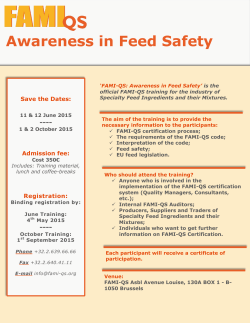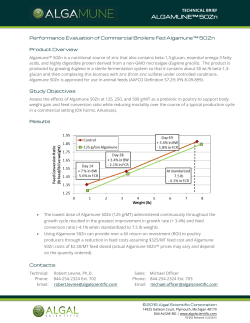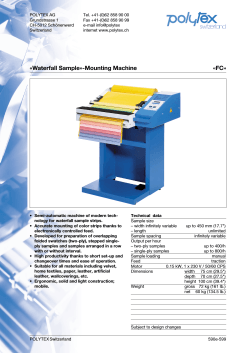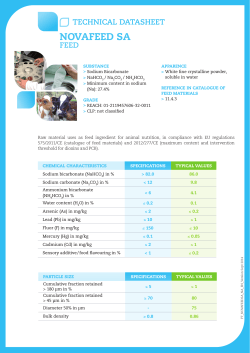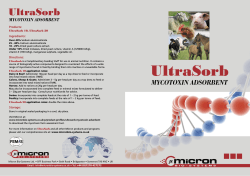
How to Prepare for the Veterinary Feed Directive (VFD)
5/8/2015
How to Prepare for the
Veterinary Feed Directive
(VFD)
Montana Nutrition Conference and
Livestock Forum April 28-29, 2015
Bruce W. Hoffman, DVM
Technical Consultant
Beef Business Unit
USBBUMUL00865
1
1
2
1
5/8/2015
A Robust Portfolio
Health Management Products
Vaccines
Antibiotics & Parasiticides
Feed Optimization Products
End-point Management Products
Micotil® (tilmicosin injection) is approved for the treatment and control of BRD.
USBBUMUL01166
3
The Good News
• Today, antibiotics used in farm animals
are not top-of-mind
• Few think about them as they shop for
food
USBBUMUL00865
7
2
5/8/2015
2013 International Consumer
Attitudes Study (ICAS)
2nd Edition: May 2013
34 studies
Unaided
questions
26 countries
100,000+
consumers
Food Buyer:
95%
• Taste
• Cost
• Nutrition
Spending data
Luxury Buyer:
4%
Fringe
• Food bans
• Restrictions
• Propositions
• Luxury/Gourmet
• Organic/Local
• Gardens
USBBUMUL00865
10
Consumer Concerns
Antibiotic use, among other things, makes consumers uncomfortable.
1-10 scale; percent responding “uncomfortable”
(1-3)
Total
Food
communicators
“I’m not aware of
this method”
Supplementing naturally occurring
animal hormones
55%
72%
2%
Using dihydrogen monoxidization (H2O) on crops &
farm animals
52%
53%
14%
Using pesticides on crops
49%
59%
1%
Administering animal antibiotics
48%
61%
1%
Using genetically modified (GMOs) or
biotech seeds
43%
51%
2%
Using fertilizers on crops
26%
31%
—
USBBUMUL00865
Source: ml&p research for USFRA, 10/11, n=1,400
14
3
5/8/2015
Consumer Concerns
Antibiotic use, among other things, makes consumers uncomfortable.
1-10 scale; percent responding “uncomfortable”
(1-3)
Total
Food
communicators
“I’m not aware of
this method”
Supplementing naturally occurring
animal hormones
55%
72%
2%
Using dihydrogen monoxidization (H2O) on crops
and farm animals
52%
53%
14%
Using pesticides on crops
49%
59%
1%
Administering animal antibiotics
48%
61%
1%
Using genetically modified (GMOs) or
biotech seeds
43%
51%
2%
Using fertilizers on crops
26%
31%
—
USBBUMUL00865
Source: ml&p research for USFRA, 10/11, n=1,400
15
The Challenge…
It’s not what you say, it’s what
they hear.
USBBUMUL00865
1717
4
5/8/2015
The Disconnect
YOU SAY
THEY HEAR
We use antibiotics to be more efficient.
Because you only care
about making money…
We use antibiotics to keep animals healthy.
You HAVE to use antibiotics because animals
are kept in poor conditions.
Regulatory agency reviews have
approved antibiotics as safe after
rigorous review processes.
We don’t know if it’s safe for the long term.
They’ve been wrong before…
There are rules that dictate maximum residue
levels allowed in animals.
How can we be sure
ANY residue is safe?
There is no evidence that use of antibiotics in
animals causes resistance in humans.
Yeah right. We’re using so many,
that has to be part of the reason.
USBBUMUL00865
18
What Do We Do?
• In a world where our audience doesn’t
TRUST
– That antibiotics are safe
– That they’re used judiciously
– That they’re used for the right reasons
USBBUMUL00865
19
5
5/8/2015
Rebuilding Trust in Antibiotics
•
•
•
•
Acknowledge concerns
Accept responsibility
Add context
Align language
USBBUMUL00865
22
Access to Antibiotics
• A public health issue
• Access to effective antibiotics
Critical for public
health
USBBUMUL00865
Vital for livestock &
poultry production
Essential for
animal well-being
24
6
5/8/2015
FDA Releases Antibiotic Guidance
• FDA goal: protect human health & curb development of
antimicrobial resistance
• 3 proposed documents to modify use of medicallyimportant antibiotics in food producing animals
Guidance for
Industry (GFI) #209
CFR 558
Guidance for Industry
(GFI) #213
USBBUMUL00865
25
Compliance Timeline
• FDA pursuing voluntary compliance
• FDA to evaluate progress 3 years after final publication
– Guidance for Industry #213 finalized Dec. 2013
– FDA will consider “further actions” as warranted
Q2, 2012:
Q2, 2013:
Q1, 2014:
209/213/VFD
published
Public
hearings
Sponsors must notify
CVM of intent to engage
Q3, 2012:
Q4, 2013:
Q1, 2017:
Docket
comments
due
Release of
final 213 &
draft VFD
Implementation
complete
Dec. 11, 2013
USBBUMUL00865
26
7
5/8/2015
Implications
• Food producers aren’t losing all
feed-grade antibiotics
• The way they’re used will change
• Key phrase is “medically-important”
– Refers to drugs important for therapeutic
use in humans
USBBUMUL00865
28
Three Classes of Antibiotics
• Human-only antibiotics are not approved for use in
animals, creating a reserve of unique antibiotics for
human health needs
• Because animals are susceptible to different diseases
& have different needs than humans, animal-only
antibiotics have been developed to treat specific
health requirements of animals & are not used in
human medicine
• Shared-class antibiotics are approved for animals &
humans. Going forward, Elanco will only promote this
class of antibiotics for therapeutic uses in animals
under veterinarian supervision
USBBUMUL00865
29
8
5/8/2015
FDA/CVM (GFI #209) Will Phase Out Performance
Indications for Certain Antibiotics
Therapeutic uses
Disease Control
Administration of an
antimicrobial to an
animal or group of
animals whose morbidity
or mortality has
exceeded baselines.
Disease Treatment
Administration of an
antimicrobial to an
animal or group of
animals that exhibit
clinical disease.
Disease Prevention
Administration of an
antimicrobial to an
animal or group of
animals that are
considered to be at risk,
but prior to onset of
clinical disease.
Growth, Nutrition,
Health Maintenance
Administration of an
antimicrobial to an
animal or group of
animals that results in
improved performance,
i.e. weight gain or feed
conversion.
No longer allowed
USBBUMUL00865
36
What Will Change?
Antibiotic classes
Animal-only
Shared-use
Performance
Ionophore — ADG/FE
Bambermycin — ADG
CTC — ADG/FE
Prevention
Ionophore — Coccidosis
Oxytetracycline — SFC
Control
Ionophore — Coccidosis
Carbodox — dysentery
Tylan — Liver abscess
CTC — Pneumonia
CTC — Liver abscess
CTC — Anaplasmosis
Treatment
Tiamulin — dysentery
CTC — Enteritis
= No longer allowed
= VFD required
USBBUMUL00865
37
9
5/8/2015
Establishment of VFDs
• First passed in 1996 (ADAA; 21 CFR 558)
• Requires a coordinated effort: producer,
veterinarian, nutritionist & feed supplier
– Requires veterinary oversight of feed use
antimicrobials
• Written statement (VFD form) by licensed
veterinarian that authorizes client/producer to obtain
& use (on designated products)
– Follow “Standards of Practice” in state where
cattle reside. Drops the requirement for VCPR
USBBUMUL00865
38
Modernizing VFD
• GFI #209 proposed to modernize & add
“shared-class” products
• This raised concerns….
– Limited experience with VFD process
– Logistical & administrative burden
– Access to veterinarians
– Increased cost (producer, vet, feedmills)
USBBUMUL00865
39
10
5/8/2015
Veterinarian Use & Oversight
• Each product approved under the VFD
regulations includes the following caution:
Caution: Federal (USA) law restricts this drug to use by or on the order of a
licensed veterinarian.
USBBUMUL00865
41
VFD Regulations on Distribution
• One-time Notifications
– Notice to FDA of distribution of VFD feeds
• Notification to FDA that you intend to handle/distribute
VFD drug-containing medicated feeds
– Acknowledgement of distribution limitations for
VFD feeds
• Document stating that the purchasers will sell the VFD
feeds only to producers with valid VFD orders or to
other distributors for whom they have
acknowledgement notices
USBBUMUL00865
44
11
5/8/2015
USBBUMUL00865
47
• Visit globalvetlink.com
to get started
• Click “Login/Sign Up”
in the top-right corner to
create a new account or
to sign in
USBBUMUL00865
50
12
5/8/2015
USBBUMUL00865
51
Key Points: Feed Antibiotics
& VFD
• Coordinated effort, but still allow judicious
use of medically-important antibiotics
– One-time notification
– Require vet oversight
– Pen or group animal detail
– Written or electronic form authorization
• Effort to protect human & animal health &
secure food safety
USBBUMUL00865
54
13
5/8/2015
Investing in Innovation
Pursue
advances &
treatments that
lessen reliance
on antibiotics
Seek new
therapeutic
indications for
treatment, control
& prevention of
diseases
Support use of
antimicrobials
used only in
animals for growth
& performance
(where permitted)
Provide services
that help verify
& validate
responsible
product use
USBBUMUL00865
59
Thank You
USBBUMUL00865
6060
14
5/8/2015
BMD and Albac are registered trademarks of Alpharma Inc.
Flavomycin is a registered trademark of Huvepharma AD.
Mecadox and Vmax are registered trademarks of Phibro Animal
Health Corporation
Denagard is a registered trademark of Novartis.
Neomix is a registered trademark of Pharmacia & Upjohn Animal Health.
Lincomix and LA-200 are the property of Zoetis Inc., its affiliates and/or its
licensors.
Elanco®, Coban®, Hygromix®, Maxiban®, Monteban®, Rumensin®, Skycis®,
Tylan® and the diagonal bars are all trademarks owned or licensed by Eli Lilly
and Company, its subsidiaries or affiliates.
© 2014 Elanco Animal Health. All rights reserved.
All other trademarks are the property of their respective owners.
USBBUMUL00865
61
How to use Tylan®* premix for swine
For ileitis control:
Recommendation:
Feed Tylan at 100 g/ton for at least 3 weeks,
followed by 40 g/ton to market weight.
Begin feeding Tylan at 12-15 weeks of age or 3 weeks prior to seroconversion,1,2
because gross or microscopic lesions appear well in advance of seroconversion/disease.
* No withdrawal required when fed according to label directions.
How to use Tylan Soluble for swine
Swine: For the treatment and control of swine dysentery, medicate with 250 mg tylosin per gallon in drinking water for 3 to 10 days, depending
upon severity of infection. Alternatively, medicate with 250 mg tylosin per gallon in drinking water for 3 to 10 days, followed by 40 to 100 g tylosin
per ton of complete feed (Type C medicated feed manufactured from TYLAN Type A medicated article) for 2 to 6 weeks. For control of porcine
proliferative enteropathies (PPE, ileitis), medicate with 250 mg tylosin per gallon in drinking water for 3 to 10 days, followed by 40 to 100 g tylosin
per ton of complete feed (Type C medicated feed manufactured from TYLAN Type A medicated article) for 2 to 6 weeks. Swine must consume
enough medicated water to provide a therapeutic dose. Only medicated water (250 mg tylosin per gallon) should be available while medicating
with TYLAN Soluble.
RESIDUE WARNING: Swine must not be slaughtered for food within 48 hours after treatment.
1. Guedes, R. 2004. “Update on epidemiology and diagnosis of porcine proliferative enteropathy.” J. Swine Health Prod. 12(3): 134-138.
2. Armbruster, G., et al. 2007. “Review of Lawsonia intracellularis seroprevalence screening in the United States, June 2003 to July 2006.”
AASV Proc.: 231-233.
USBBUMUL00865
62
15
5/8/2015
How to use Tylan® premix for broilers and breeders
• For increased rate of weight gain feed Tylan at:
- Tylan 40 per ton of Type C feed: 0.1 to 1.25 lbs.
- Tylosin per ton of Type C feed: 4 to 50 g
• To aid in the control of chronic respiratory disease associated with Mycoplasma gallisepticum:
- Tylan 40 per ton of Type C feed: 20 to 25 lbs.
- Tylosin per ton of Type C feed: 800 to 1,000 g
• Feed continuously as the sole ration.
• Tylan requires a 5-day withdrawal period before slaughter when fed at 800-1,000 g/ton.
How to use Tylan Soluble for broilers
• As an aid in the treatment of chronic respiratory disease (CRD) caused by Mycoplasma gallisepticum sensitive to tylosin in broiler and
replacement chickens. For the control of chronic respiratory disease (CRD) caused by Mycoplasma gallisepticum sensitive to tylosin at time of
vaccination or other stress in chickens. For the control of chronic respiratory disease (CRD) caused by Mycoplasma synoviae sensitive to
tylosin in broiler chickens.
• Chickens should be treated for 3 days; however, treatment may be administered for 1 to 5 days depending upon severity of infection. Treated
chickens must consume enough medicated water to provide 50 mg/lb. of body weight per day. Only medicated water should be available to the
birds.
How to use Tylan Soluble for turkeys
• For maintaining weight gain and feed efficiency in the presence of infectious sinusitis caused by Mycoplasma gallisepticum sensitive to tylosin.
• Turkeys should be treated for 3 days; however, treatment may be administered for 2 to 5 days depending upon the severity of infection.
Treated turkeys must consume enough medicated water to provide 60 mg/lb. of body weight per day. Only medicated water should be
available to the birds.
USBBUMUL00865
63
How to use Tylan® Premix for beef cattle
• For reduction of incidence of liver abscesses associated with Fusobacterium necrophorum and Arcanobacterium pyogenes:
- Feed tylosin continuously at 8-10 g/ton (90% DM) to deliver 60-90 mg/hd/d.
Hygromix® directions for use
• For use as an aid in the control of parasite infections in chickens associated with Ascaris galli, Heterakis gallinae and Capillaria obsignata.
• Mix 1.0-1.5 lbs. Hygromix 8 per ton of Type C medicated feed for 8-12 g of hygromycin B per ton.
• Feeds containing Hygromix must be withdrawn 3 days prior to slaughter.
Recommendation1,2
Feed to pullets and breeders at 12 g/ton from placement through 50 weeks.
The labels contain complete use information, including cautions and warnings.
Always read, understand and follow the label and use directions.
1. Eckman, M. 1998. “Controlling Helminth Parasites in Layer, Broiler Breeder Flocks.” Poultry Sci. June/July.
2. Shumard, R., et al. “Hygromycin B: An Anthelmintic for Effective Control of Nematode Parasites of Chickens.” Symposium of Tylan and Hygromix.
USBBUMUL00865
64
16
5/8/2015
Coban® for broilers and breeders
• For coccidiosis prevention, feed Coban at 90-110 g/ton.
• Feed continuously as the sole ration.
• Requires a zero-day withdrawal (when fed according to the label).
CAUTION: Ingestion of monensin by horses and guinea fowl has been fatal.
Coban® for turkeys
• For coccidiosis prevention, feed Coban at 54-90 g/ton.
• Feed continuously as the sole ration.
• Requires a zero-day withdrawal (when fed according to the label).
CAUTION: Ingestion of monensin by horses and guinea fowl has been fatal.
Skycis® indications
Appropriate concentrations of narasin in Type C
Medicated Feed
Increased rate of weight gain in growing-finishing swine when fed for
at least 4 weeks.
13.6 to 27.2 g/ton (15 ppm to 30 ppm)
Increased rate of weight gain and improved feed efficiency in growingfinishing swine when fed for at least 4 weeks.
18.1 to 27.2 g/ton (20 ppm to 30 ppm)
No increased benefit in rate of weight gain has been shown when narasin concentrations in the diet are greater than 13.6 g/ton (15 ppm).
No withdrawal period is required when used according to the label.
Cautions:
– Swine being fed with Skycis (narasin) should not have access to feeds containing pleuromutilins (e.g., tiamulin) as adverse reactions may
occur. If signs of toxicity occur, discontinue use.
– Do not allow adult turkeys, horses or other equines access to narasin formulations. Ingestion of narasin by these species has been fatal. Not
approved for use in breeding animals because safety and effectiveness have not been evaluated in these animals.
USBBUMUL00865
65
Maxiban® directions for use
• For coccidiosis prevention, feed Maxiban at 54-90 g/ton.
• Feed continuously as the sole ration.
• Requires a 5-day withdrawal.
CAUTION: Ingestion of narasin by adult turkeys, horses or other equine species has been fatal. Do not feed to laying hens.
Monteban® directions for use
• For coccidiosis prevention, feed Monteban at 54-90 g/ton.
• Feed continuously as the sole ration.
• Requires a zero-day withdrawal (when fed according to label).
CAUTION: Ingestion of narasin by adult turkeys, horses or other equine species has been fatal. Do not feed to laying hens.
Rumensin® directions for use
Consumption by unapproved species or feeding undiluted may be toxic or fatal. Do not feed to veal calves.
Dairy Cow: For increased milk production efficiency (production of marketable solids-corrected milk per unit of feed intake):
Total Mixed Rations: Feed continuously to dry and lactating dairy cows a total mixed ration ("complete feed") containing 11 to 22 g/ton
monensin on a 100% dry matter basis.
Component Feeding Systems (including top dress): Feed continuously to dry and lactating dairy cows a Type C Medicated Feed containing
11 to 400 g/ton monensin. The Type C Medicated Feed must be fed in a minimum of 1 pound of feed per cow per day to provide 185 to 660
mg/head/day monensin to lactating cows or 115 to 410 mg/head/day monensin to dry cows. This provides cows with similar amounts of
monensin they would receive by consuming total mixed rations containing 11 to 22 g/ton monensin on a 100% dry matter basis.
Growing cattle on pasture or in dry lot (Dairy replacement heifers): For increased rate of weight gain: Feed at the rate of not less than 50
nor more than 200 mg/head/day in not less than 1 pound of Type C Medicated Feed; or after the 5th day, feed at the rate of 400 mg/head/day
every other day in not less than 2 pounds of Type C Medicated Feed. The monensin concentration in the Type C Medicated Feed must be
between 25 and 400 g/ton. During the first 5 days, cattle should receive no more than 100 mg/day contained in not less than 1 pound of feed.
Do not self feed.
For the prevention and control of coccidiosis due to Eimeria bovis and Eimeria zuernii: Feed at a rate to provide 0.14 to 0.42 mg per
pound body weight per day, depending upon severity of challenge, up to a maximum of 200 mg/head/day. The monensin concentration in Type
C Medicated Feed must be between 25 and 400 g/ton. During the first 5 days, cattle should receive no more than 100 mg/day contained in not
less than 1 pound of feed.
USBBUMUL00865
66
17
5/8/2015
Important Safety Information
•
See label on slide 63 for complete use information, including boxed human
warnings and non-target species safety information.
•
Micotil is to be used by, or on the order of, a licensed veterinarian. For cattle or
sheep, inject subcutaneously. Intravenous use in cattle or sheep will be fatal. Do not
use in female dairy cattle 20 months of age or older. Use in lactating dairy cattle or
sheep may cause milk residues.
•
The following adverse reactions have been reported: in cattle: injection site swelling
and inflammation, lameness, collapse, anaphylaxis/anaphylactoid reactions,
decreased food and water consumption, and death; in sheep: dyspnea and death.
•
Always use proper drug handling procedures to avoid accidental self-injection. Do not
use in automatically powered syringes.
•
Consult your veterinarian on the safe handling and use of all injectable products prior
to administration.
•
Micotil has a pre-slaughter withdrawal time of 42 days.
USBBUMUL00865
67
Boxed Warning
CAUTION: Federal (USA) law restricts this drug to
use by or on the order of a licensed veterinarian.
Human Warnings: Not for human use. Injection of this drug in humans has
been associated with fatalities. Keep out of reach of children. Do not use in
automatically powered syringes. Exercise extreme caution to avoid
accidental self-injection. In case of human injection, consult a physician
immediately and apply ice or cold pack to injection site while avoiding direct
contact with the skin. Emergency medical telephone numbers are 1-800-7220987 or 1-800-428-4441. Avoid contact with eyes.
Note To The Physician: The cardiovascular system is the target of toxicity and
should be monitored closely. Cardiovascular toxicity may be due to calcium
channel blockade. In dogs, administration of intravenous calcium offset
Micotil-induced tachycardia and negative inotropy (decreased contractility).
Dobutamine partially offset the negative inotropic effects induced by Micotil
in dogs. ß-adrenergic antagonists, such as propranolol, exacerbated the
negative inotropy of Micotil in dogs. Epinephrine potentiated lethality of
Micotil in pigs. This antibiotic persists in tissues for several days.
USBBUMUL00865
68
18
5/8/2015
USBBUMUL00865
69
19
© Copyright 2025
